Related Research Articles
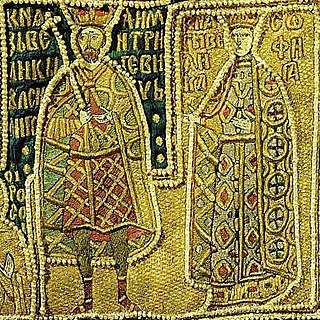
Vasily I Dmitriyevich was the Grand Prince of Moscow, heir of Dmitry Donskoy. He ruled as a Golden Horde vassal between 1389 and 1395, and again in 1412–1425. The raid on the Volgan regions in 1395 by Mongol emir Timur resulted in a state of anarchy for the Golden Horde and the independence of Moscow. In 1412, Vasily reinstated himself as a vassal of the Horde. He had entered an alliance with the Grand Duchy of Lithuania in 1392 and married the only daughter of Vytautas the Great, Sophia, though the alliance turned out to be fragile, and they waged war against each other in 1406–1408.
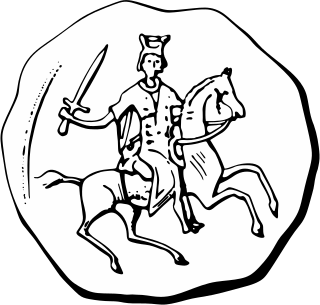
Vladimir-Suzdal, also Vladimir-Suzdalian Rus', formally known as the Grand Duchy of Vladimir (1157–1331), was one of the major principalities that succeeded Kievan Rus' in the late 12th century, centered in Vladimir-on-Klyazma. With time the principality grew into a grand duchy divided into several smaller principalities. After being conquered by the Mongol Empire, the principality became a self-governed state headed by its own nobility. A governorship of principality, however, was prescribed by a Khan declaration (jarlig) issued from the Golden Horde to a noble family of any of smaller principalities.

Vladimir is a city and the administrative center of Vladimir Oblast, Russia, located on the Klyazma River, 200 kilometers (120 mi) to the east of Moscow. It is served by a railway and the M7 motorway. Its population is 345,373 (2010 Census); 315,954 (2002 Census); 349,702 (1989 Census).

Yuri II, also known as George II of Vladimir or Georgy II Vsevolodovich, was the fourth Grand Prince of Vladimir who presided over Vladimir-Suzdal at the time of the Mongol invasion of Rus'.

Prince Andrey II Yaroslavich was the third son of Yaroslav II who succeeded his uncle Svyatoslav III as the Grand Duke of Vladimir in 1249. Three years later, he challenged the Mongols and was ousted by them from Russia.

Saint Dionysius I ; secular name: David was a Russian Orthodox metropolitan in 1384–1385.
Venerable Macarius of the Yellow Water Lake and the Unzha, the Miracle Worker (1349–1444) is a Russian Orthodox saint. He is credited with the founding of four monasteries in the Middle and Upper Volga regions of Russia.

Pechersky Ascension Monastery is a monastery in Nizhny Novgorod, Russia. It is the principal monastery of the Nizhny Novgorod Eparchy (diocese) and the seat of the Bishop of Nizhny Novgorod and Arzamas.
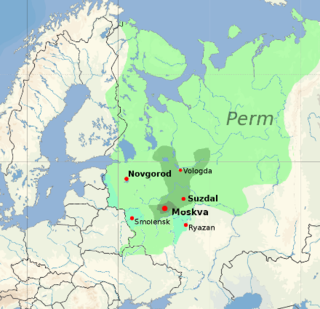
The Grand Duchy of Moscow, Muscovite Russia, Muscovite Rus' or Grand Principality of Moscow was a Rus' principality of the Late Middle Ages centered on Moscow, and the predecessor state of the Tsardom of Russia in the early modern period. It was ruled by the Rurik dynasty, who had ruled Rus' since the foundation of Novgorod in 862. Ivan III the Great titled himself as Sovereign and Grand Duke of All Rus' '

Kievan Rus' or Kyivan Rus', was a loose federation of East Slavic and Finno-Ugric peoples in Eastern and Northern Europe from the late 9th to the mid-13th century, under the reign of the Rurik dynasty, founded by the Varangian prince Rurik. The modern nations of Belarus, Russia, and Ukraine all claim Kievan Rus' as their cultural ancestors, with Belarus and Russia deriving their names from it. The Rurik dynasty would continue to rule parts of Rus' until the 16th century with the Tsardom of Russia. At its greatest extent, in the mid-11th century, it stretched from the White Sea in the north to the Black Sea in the south and from the headwaters of the Vistula in the west to the Taman Peninsula in the east, uniting the majority of East Slavic tribes.
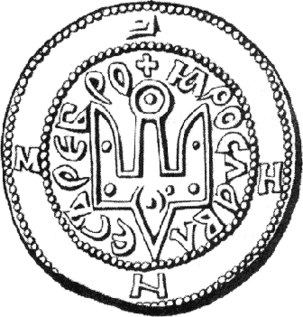
The Rurik dynasty, or Rurikids, was a dynasty founded by the Varangian prince Rurik, who established himself in Novgorod around the year AD 862. The Rurikids were the ruling dynasty of Kievan Rus' before it finally disintegrated in the mid-13th century, as well as the successor Rus' principalities and Rus' prince republics of Novgorod, Pskov, Vladimir-Suzdal, Ryazan, Smolensk, Galicia-Volhynia, Chernigov, and the Grand Duchy of Moscow.
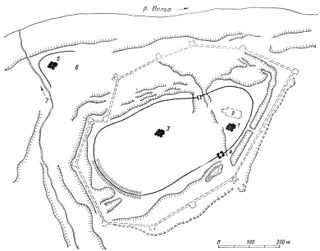
Sary-Aka's embassy was a mission from the commander of the Blue Horde Mamai sent to the Russian Eastern border province of Nizhny Novgorod in 1374 to undermine the influence of the Prince of Moscow in his struggle for supremacy among the Russian provinces due to his open opposition to Mongol authority in Russia. The embassy was ambushed and the survivors were imprisoned in the wooden fort of Nizhny Novgorod until the 31st of March 1375 when Sary-Aka with the rest of Tatars were massacred by Russians.
Kirill II of Kiev was a church figure, and the metropolitan of Kiev, close to the Horde king Mengu-Timur.

Vladimir Diocese is an eparchy of the Russian Orthodox Church centered in Vladimir Oblast, Russia. The main cathedral of the diocese is the Assumption Cathedral in the Cathedral Square of Vladimir.

The Tver Uprising of 1327 was the first major uprising against the Golden Horde by the people of Vladimir. It was brutally suppressed by the joint efforts of the Golden Horde, Muscovy and Suzdal. At the time, Muscovy and Vladimir were involved in a rivalry for dominance, and Vladimir's total defeat effectively ended the quarter-century struggle for power. The Golden Horde later became an enemy of Muscovy, and Russia did not become free of Mongol influence until the Great stand on the Ugra river in 1480, more than a century later.

Nizhny Novgorod was founded by Prince Yuri II of Vladimir in 4 February 1221. Citizens organized an army to liberate Moscow from the Poles in 1611, led by Kuzma Minin and Prince Dmitry Pozharsky. During the Russian Empire, in 1817 Nizhny Novgorod became the country's main trading city. In 1896, the city hosted the largest All-Russia exhibition. In the Soviet era, Nizhny Novgorod was renamed Gorky, in honor of the writer Maxim Gorky. Then it was the industrial center of the Soviet Union. During the World War II, the city sent to the front a huge amount of military equipment and ammunition. Therefore, the German air force bombed the city for 3 years. After the dissolution of the Soviet Union, the city was renamed back to Nizhny Novgorod. In Russia, the city became a political center and the capital of the Volga Federal District. Now the city is the center of information technology and develops tourism.
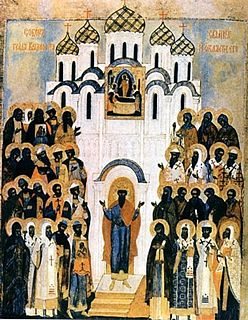
The Synaxis of all Saints of Vladimir is a holiday in honor of the saints of the Russian Orthodox Church, whose life was connected with the territory of the present Eparchy of Vladimir. It is held on June 23, according to the old style, which falls on July 6 for a new style. The synaxis festival was established in 1982 with the blessing of Patriarch Pimen on the day of the celebration of the Theotokos of Vladimir.
References
- ↑ "Witches were executed at Novgorod in 1227, and after a severe famine in the years 1271-4 Bishop Serapion of Vladimir asked in a sermon: 'you believe in witchcraft and burn innocent people and bring down murder upon earth and the city... Out of what books or writings do you learn that famine in earth is brought about by witchcraft?'", Behringer, "Witches and Witch-hunts: a Global History", p. 56 (2004). Wiley-Blackwell.
- "Serapion of Vladimir" in The Oxford Dictionary of Byzantium (1991)
- "Serapion of Vladimir (1275)" in The Oxford Dictionary of the Middle Ages (2010)